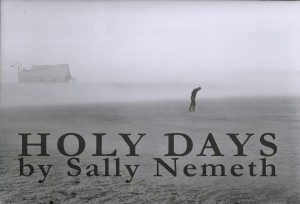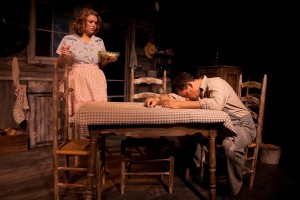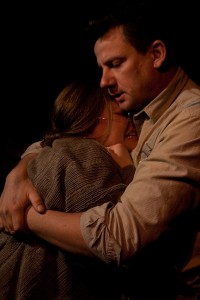
Retro Productions’ latest show, Holy Days (Written by Sally Nemeth and directed by Peter Zinn) comes off as deceptively simply until you’ve sat with it a while. It’s been several days since I’ve seen it and I find that I’m haunted by the seemingly stark yet surprisingly deep performances by Heather E. Cunningham (Rosie), Joe Forbrich (Gant), Lowell Byers (Will) and Casandera M.J. Lollar (Molly).
Holy Days begins with a metaphor, one which shifts the more you think about it. At the opening of the play, Rosie addresses the audience with an empty gaze and a lilt-less voice to explain how she had once seen her garden full of daffodils which were in danger of being covered in frost; she gathered as many as she could into her arms, thinking she’d taken more than enough to fill all the vessels she had in the house. But when she was able to arrange them, they barely filled one pitcher. She went out to take more, but the remaining flowers were dried up … gone.
Certainly, since Holy Days takes place during the Great Depression in the Dust Bowl, one can make the obvious connection that this story is an analogy for the way life just dried up on the plains, how colors faded and

Casandera M. J. Lollar and Joe Forbrich (photo by Jordana Zeldin)
hope left. However, sit with this image for a while and it grows deeper – the idea becomes one of need. Needing to hoard the good moments, feeling almost overwhelmed by them when you have them, thinking you’ve got more life, love, goodness, and prosperity than you can handle, only to find it’s barely enough … and when you move to get another shot at happiness you find the prospects have all dried up.
Holy Days is also a metaphor for death, mourning and rebirth, but mostly it’s about the in-between … the waiting. For those who know their Christian calendar, these particular holy days in the play refer to Good Friday – the day Christ died, Holy Saturday, the day he was deeply missed and strongly mourned, and Easter Sunday, they day he rose and restored hope and faith. When we come upon Rosie, her husband Gant, his brother Will, and Will’s wife Molly, they seem to be stuck (metaphorically) in the mournful day of Holy Saturday even as they are literally preparing for Easter. No doubt their Good Friday has past – clues are passed along thought the ways of their daily life as well as things that are hinted at – yes, the Great Depression has hit, but this family has lost a lot more. And no doubt their Easter Sunday is coming – Molly is pregnant and full of eager anticipation to start her life; she’s annoyed by anything that smacks of hurt and detachment … she wants fun, and renewal, and affirmation. And so, this family wallows in this never ending day of waiting … full of mourning for the death they’ve seen in all its forms, and bowed with diminishment … doing what they can to figure out how to keep themselves together even if the only way to accomplish that is through separation.

Heather Cunningham and Joe Forbrich (photo by Jordana Zeldin)
Each of the four characters is strongly carved out; they have all lived through the same dark episode but represent four different stages of acceptance. Heather E. Cunningham’s Rosie is suffering deeply from a loss which has taken her hope and her heart, but there are still moments of anger in her, and where there’s anger there’s at least a spark of life. She tightly wraps her depression around her as if it were the ratty sweater she can’t keep from pulling closer and closer. Joe Forbrich’s Gant is the strong and silent type, he suffers as deeply as his wife, but he’s tasked as “the man” and so he must bear the burden of tending to the farm, looking for work in order to pay the mortgage, and resolutely abiding by the unwritten rules of the times that if going off to build a bridge for three years is what you must do to keep your family together, then you do it without hesitation. It’s in the quite moments that he drowns his sorrows in liquor and lets the alcohol dull his ache. Casandera M.J. Lollar’s Molly is desperate to cast off these depressing relatives; she’s been part of the tragedies from a distance, and even her closing speech underlines the fact that she is unwilling to give over to this oppressive social and economical environment. A gesture as simple as needing to color Easter eggs perfectly pinpoints how she must look for the promise of tomorrow. Unfortunately, it leads to an almost cruel attitude toward her sister-in-law that presents itself in between otherwise mundane moments like baking a pie or milking the cow. Finally, Lowell Byers’ Will represents youth, energy and hope. He’s strong, both in character as well as build, and he’s been lucky enough to suffer less than his brother, even while he steadfastly sticks by him. However, he does suffer for his brother, for the loss and the under-expressed sorrow … he even sheds tears of his own. But ultimately he’s been spared and that gives him something that’s in short supply around the farm –optimism. Subtle, but present optimism.
With an amazingly detailed set by Jack and Rebecca Cunningham and Justin Sturges, and property design by Heather E. Cunningham and Casandera M. J. Lollar the world of this family rises up around you and you can feel the dust come in on the wind every time the door is opened. While Holy Days could never be called a happy story, it most certainly is a beautiful one, filled with all the places the human spirit goes when facing down its greatest enemy: misfortune.
For an in-depth conversation with Heather Cunningham where she discussed this play, her role as Rosie, and more about her life in the theatre, check out Antonio Minino’s great interview which ran a few weeks ago.
—
Holy DaysNovember 6 – November 21 @ 8PM
The Spoon Theater
38 West 38th Street, 5th Floor New York , NY



{ 1 comment… read it below or add one }
Great review, Karen!
I saw it the last night of the run, and considering that the play was a difficult one to do without it being all dark and depressing, they did a very good job.
I was not surprised that Lowell Byers stole the show for me; not just because I’m familiar with his work (I have also seen Heather Cunningham in Retro’s production of “When You Comin’ Back, Red Ryder?” and she’s great) but because he is what kept the play from being completely dark and depressing, but at the same time showed, during his monologue, the depth of his pain as well.
That said, all the actors did a fine job. It’s just very difficult, when you have material that is already so dark, to not play things on one note, despite the material. They stood up to the challenge for the most part!